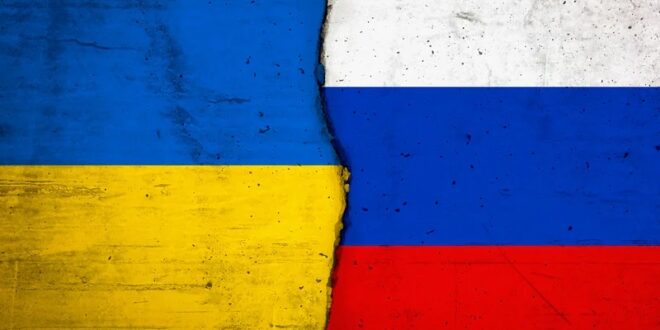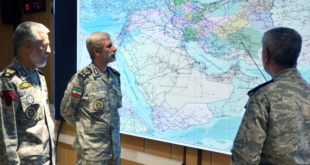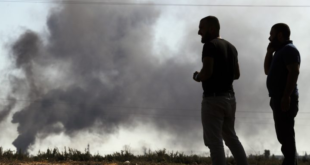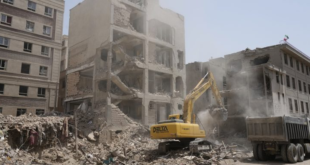The Russian army’s attack on Ukraine is now in its third month. How might the conflict evolve? Here are four of the most common scenarios and what they would mean for the economy.
Scenario 1: Diplomacy Triumphs
What is the outlook for diplomacy at a time when Russia continues to pound Ukraine and the West continues to deliver weapons, particularly heavy weapons, to Kyiv? to On April 28, Turkish President Recep Tayyip Erdogan told his Russian counterpart Vladimir Putin that his country was ready to take the lead in initiating a process to end the war in Ukraine and to propose a long-term peace. Turkey did play a mediating role in the prisoner swap between Moscow and Washington on April 27. It also served as a venue for two direct talks between Russians and Ukrainians. Erdogan’s proposal, however, is the tree that hides the forest.
At the multilateral level, UN Secretary General Antonio Guterres tried, but failed, to persuade the Kremlin to negotiate a cease-fire on April 26. He even invited Moscow to join the International Criminal Court’s efforts, but did not manage to convince the Russians.
Negotiations to end the war in Ukraine are currently extremely unlikely. There may be tactical arrangements in place, such as the establishment of humanitarian corridors. However, rare are those who expect strategic talks to take place before the end of the year. is unmistakably in an escalation phase.
This is a far cry from the diplomatic efforts made by French President Emmanuel Macron or German Chancellor Olaf Scholz shortly before the Russian invasion began. Instead, European countries are focusing on remaining united and delivering arms to Ukraine to strengthen its resistance capacities. The U.S. is also in the same dynamic, preferring to deprive Russia of the ability to launch a similar type of invasion in the future. It follows that one has to be skeptical of active European diplomacy. Nobody in Europe is going to go out of their way to help Putin. It is more a matter of fortifying the Ukrainian resistance. For instance, the EU’s high representative for foreign affairs, Josep Borrell, has not resumed contact with Moscow. In a blog post on April 26, he stated that “after two months of fighting in Ukraine, there is no end in sight, and Russia’s recent actions point to a worsening of the situation.”
Expulsions of diplomats have followed one another at a frantic pace, indicating that bridges between Europe and Russia are partially broken. Moscow expelled 40 German diplomats on April 26 in retaliation for the expulsion of 40 Russian diplomats from Germany who, according to Berlin, were not engaged in diplomacy but in intelligence work. The West should wait and see if the Kremlin suddenly sees the need to negotiate, say, a partial withdrawal and a return to the 2014 status quo (when Russia annexed Crimea and controlled part of the Donbass). Putin will consider this a victory. Including Ukraine’s neutrality in an agreement could change his mind, though. On the U.S. side, which has given Ukraine $3.7 billion in aid since 2021, the head of diplomacy, Antony Blinken, doesn’t see any sign that Putin is really ready to “negotiate seriously.”
Economic Outlook
We should not expect a quick return to normalcy. If the talks are successful, energy and commodity prices will fall gradually. A decline in market risk aversion and a shock to business and consumer confidence means that growth in 2022 is likely to be close to what was expected at the start of the year.
Ukraine and Russia will be increasing their exports of energy, agricultural products, and mining raw materials. Before the invasion of Ukraine, the price of a barrel of oil had already reached $90 due to increased demand in the post-Covid period.
Sanctions against Russia will be gradually lifted by the European Union, the United States, and their allies. Moscow will earn money from gas and oil exports and massive international reconstruction aid will arrive in Ukraine.
Scenario 2: New Trench Warfare
Has Russia lost its grip on Ukraine two months after the invasion began? On March 25, Moscow had already reduced its war objectives. Russian forces have given up on taking and even encircling Kyiv and are now focusing on conquering the Donbass region of eastern Ukraine. Since the conflict began in 2014, this predominantly Russian-speaking region larger than Switzerland has been in the hands of Moscow-backed separatists. It is estimated that separatists and Russian forces now control roughly half of the territory of the provinces (oblasts) of Donetsk and Lugansk.
Donbass, the Epicenter of the Conflict
The success or failure of Russia’s major offensive against the Donbass, which began on April 18, will be critical to the outcome of this war. On this front, where Moscow has committed 70,000 men against the spearhead of the well-entrenched Ukrainian army, information is patchy. The heart of the Ukrainian defensive system is based on urban areas, which are extremely difficult to conquer, as the long siege of Mariupol demonstrated. It is doubtful that Russia will be able to break through to the front lines. A large encirclement of Ukrainian forces throughout the Donbass also appears implausible. Attacks and counterattacks will most likely be limited.
As a result, a primarily positional war has begun in that part of Ukraine, with massive use of artillery. The Russian army appears to be trying to learn from its previous mistakes by moving much more cautiously after preparing the ground with intensive strikes. Despite significant human and material losses, the Russian army retains far superior firepower. Ukraine’s allies are trying to close the gap by providing it with increasingly heavy and sophisticated weapons.
Winning the Donbas battle is equivalent to seizing a rectangle with a frontage of 100 kilometers and a depth of 70 kilometers, the size of a French department. All other things being equal, it would take Russian forces between two and three months to seize this rectangle.
What happens next could be determined by the Russian army’s success or failure in the Donbass. Moscow’s true intentions in terms of future objectives in Ukraine are unclear. In mid-April, Major General Rustam Minnekayev, acting commander of Russia’s Central Military District, was quoted by official Russian news agencies as saying that the Russian army would be unable to take on the Donbass. According to him, the goal of the second phase of the “special military operation” was to deprive Ukraine of access to the Black Sea as far as Odessa, as well as to the border with Transnistria. The general also alluded to Moldova’s separatist region, where the Russian-speaking population is “oppressed.” The same argument is made about the Russian population in the Donbas.
Southern Ukraine was the scene of the most spectacular Russian advances in the early weeks of the war. However, Russian forces have recently stalled and must instead defend their gains. A landing combined with a land offensive towards the port of Odessa does not appear to be in the cards for the time being, especially after the sinking of the flagship Moskva in the Black Sea in mid-April, most likely by Ukrainian missiles. Despite going through difficulties, Moscow has not given up on gaining control of Ukraine’s most strategic regions: the Donbass and its mineral resources, as well as the country’s maritime coastline.
Economic Outlook
The stalemate scenario would exacerbate the world’s inflationary push. However, falling demand may cause energy prices to fall. Because Ukraine cannot export by sea, many agricultural and mining operations have been abandoned. Western assistance is needed now more than ever to keep the country from going bankrupt.
Russia’s economy is deteriorating even further. The country is paralyzed as a result of the sanctions. Moscow is paying a high price to keep troops in the Donbass and Crimea. The world runs the risk of food shortages and an uprising in emerging countries because agricultural work cannot be carried out, particularly in Ukraine.
Uncertainty is preventing any investment on a global scale. Central banks are struggling to keep their liquidity levels stable. Developing countries have been hit particularly hard and are spiraling into debt.
Scenario 3: Conflict Expansion
For the time being, the conflict is between Russia and its neighbor, Ukraine, which is being invaded. With the increasing involvement of Ukraine’s allies, as well as the acceleration and escalation of arms deliveries to Kiev, the Ukrainian army should be able to counter the Russian offensive before possibly counter-attacking or even liberating a larger portion of Ukrainian territory. However, this increase in power carries the risk of escalation. Russia is threatening a third world war in order to dissuade Ukraine’s supporters.
The West has so far refused to send troops to Ukraine. Putting boots on the ground would make the West a co-belligerent in the conflict. Similarly, it has consistently resisted President Volodymyr Zelensky’s demands for a no-fly zone in Ukrainian skies to prevent NATO planes from colliding with Russian MiGs.
Nonetheless, military aid to Ukraine is rapidly increasing. On March 16, President Biden announced $800 million in new security assistance to Ukraine, hours after Ukraine President Volodymyr Zelenskyy pleaded with Congress and the president to approve a NATO-enforced no-fly zone over Ukraine. On April 28, Biden urged lawmakers to quickly approve a proposed $33 billion-plus spending package that will last through the end of September. A portion of these funds would come from Russian assets confiscated by the U.S. The U.S. is “not attacking” Russia, but rather “assisting Ukraine in defending itself against Russian aggression,” he said in a White House speech.
Given the magnitude of these sums, delivery of the weapons and logistics will be the sinews of a war that could last months, if not years. Russia has frequently declared that it has destroyed hangars that house Western military equipment. Ukrainian soldiers are being trained in handling Western weapons outside the country’s borders in order to avoid a direct confrontation with Russia. However, if this training becomes widespread, Moscow may be tempted to target bases in Ukraine’s neighbors. This might trigger the invocation of Article 5, thereby drawing NATO into the war and dramatically expanding the scope of the conflict.
If Russia wants to stop the flow of weapons, it will have to increase its strikes on convoys and possibly even close Ukraine’s western borders. Both options are out of reach for Russian capabilities. The Russian army already struggles to hit moving targets, and its stockpile of precision-guided missiles is limited.
Moscow is also becoming increasingly concerned about Ukrainian strikes on Russian territory. On March 31, the first raid targeted a fuel depot in Belgorod, one of the Russian offensive’s rear bases. Recently, ammunition and fuel depots near the border have caught fire. Moscow accused the West of inciting these attacks and issued a warning.
The problem is that we don’t know what Russia’s red lines are. Instead of being able to declare a major victory on May 9, the day of the military parade commemorating the defeat of Nazi Germany, Russia could be tempted by a verbal escalation. More bellicose rhetoric against Ukraine and NATO, or even a declaration of war, would galvanize Russian opinion and open the door to sending conscripts to Ukraine, where casualties are already in the thousands.
Economic Outlook
In this scenario, it is likely that Russia will decide to cut off the gas and oil supplies to the entire European Union, just as it decided to turn off the gas to Poland and Bulgaria at the beginning of May. The European economy will be suffering. Germany is entering a recession as its GDP will fall by at least 5% in 2022, and by up to 20% if the war lasts several months.
The price of hydrocarbons, agricultural and mining commodities will be under increasing pressure. The United States, which had previously been relatively unaffected, will be now feeling the effects of the war. International trade will be contracting. The world economy will be destabilized, and this will be exacerbated if the Atlantic Alliance decides to go to war with Ukraine.
Russia’s export revenues will be dwindling. China and India are purchasing oil and gas from it, but only as much as they require. Finally, Ukraine will become more reliant on aid from Western countries.
Scenario 4: Russia’s Defeat
Is it possible for Russia to lose in Ukraine? In all likelihood, this is not possible, not because Ukrainian forces are unable to inflict significant damage on the Russian army, but rather because Russia will never concede defeat. For Putin, defeat is unthinkable. The Russian President will always find a way to justify this or that setback.
On the ground, it is difficult to predict what Moscow will achieve with its massive offensive in the East at this time. But, if Russia were on the verge of losing, what would be the ramifications? Russia, when cornered, may resort to desperate measures. This is partly what it has done in its scorched-earth policy in its attempt to seize control of Ukraine. In the event of defeat, Moscow may seek to further destabilize the country by orchestrating provocations. However, nothing is ruled out within the realm of possibilities.
The most logical solution for Moscow would be to accept a cease-fire on current positions in order to gain time and give the appearance of negotiating. It could revert to a frozen conflict with re-enacted front lines. This would be the most acceptable scenario on a global scale. It would drown out Russia’s fear of failure. However, Putin’s reactions could be much more ‘irrational’. Nobody knows what Putin is thinking, including the occupants of the Kremlin, but he could order the use of chemical and biological weapons. The message sent to NATO member states would be extremely counterproductive. The use of these weapons of mass destruction would further isolate Russia while increasing aid to Ukraine.
The Nuclear Threat
The Russian government may consider using an even more dangerous weapon: a nuclear weapon. Russia’s nuclear posture does not rule out the use of tactical nuclear weapons in limited circumstances. If the Kremlin decides to use nuclear weapons, it risks alienating China and India, both of which are nuclear powers. Furthermore, if the use of nuclear weapons is decided upon and it affects neighboring NATO member countries, this could result in a very dangerous escalation. However, such risky actions to cover up a Russian defeat are likely to cause serious upheaval in Russia. Putin has already cleaned house in the FSB (intelligence) and army. Furthermore, with the likely suicides of a number of oligarchs, the deaths of several generals, and the impact of Western sanctions, Putin may face serious internal challenges.
Russia is unlikely to win the war because it is difficult to understand Russia’s true objectives in Ukraine. Putin’s objectives have shifted dramatically since the conflict began, and it is unclear what the bare minimum he would like to achieve, given the already astronomical cost of the invasion to Russia, which will skyrocket if the war drags on for months.”
Economic Outcome
Even though the country is rich in natural resources, Russia is embarking on a long road to the cross. The evolution of its economy will be determined by the performance of large Russian corporations. It remains to be seen whether they will change and engage in more constructive dialogue with the European Union and the rest of the world. Russian power could be restructured. Also visible is the location of China, whose investors purchased foreign companies that fled the country during the war.
Following Russia’s failure and the gradual return of certainty, oil and gas prices should fall. The European economy is benefiting from the end of the double shock of the COVID and the war.
With funding from the United States and the European Union, the Ukrainian government immediately began to rebuild the country that was in ruins. Foreign investors are drawn to infrastructure projects as well as agricultural and mining resources.
 Eurasia Press & News
Eurasia Press & News




